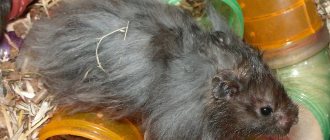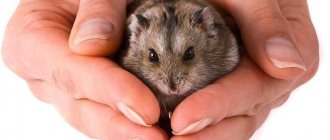Determining the sex of the Djungarian hamster is necessary in order to choose the right name for the pet and get the opportunity to start breeding these rodents. This can be done by the appearance, behavior and genitals of the animal.
Let's find out at what age it is easier to distinguish a boy from a girl, and which method of determining gender is the most reliable.
The importance of gender determination
For breeders who are engaged in breeding hamsters, when buying a hamster, it is especially important to know its gender, because the success of the animal business depends on it. For example, they may sell you a hamster that is not the gender you want. It will be unpleasant and you will have to buy the animal again.
And if you are buying a hamster just as a pet, it will be a shame if they sell you the wrong one. You may have already come up with a nickname for him, and then you’ll have to come up with it again.
Types of domestic rodents
Small animals are quite beneficial pets in all respects. They take up little space. For comfort, a small aquarium or cage is enough for them. Grains, greens, nuts and seeds will be excellent food for your little pet. As care, you can get by with periodic cleaning of the home and filling the feeders and drinking bowls. In short, rodents are the optimal solution for purchasing a pet.
Today there are many varieties of domesticated small animals. The most popular of them are:
- Guinea pigs.
- Decorative rabbits.
- Chipmunks.
- Decorative rats
- Chinchillas.
- Chilean squirrels.
- Gerbils.
But the most frequent guests of the family are hamsters.
At what age is gender determined?
Many people wonder at what age can the sex of a hamster be determined? After all, if you breed hamsters, you need to know what gender of hamster you are selling. This is where a problem arises, because at a young age it is not recommended to touch dzhungarikas - this is dangerous for their health.
If you have newborn hamsters, you will have to wait a month, then it will be clear who you have: a male or a female. By the age of four weeks, you can safely determine the age of the dzhungarika.
Brief characteristics of dzhungariks
Not always sellers in a pet store and even breeders (especially those without experience in breeding animals) are trained to recognize male and female individuals . It happens that the seller of hamsters deliberately misleads in order to sell “stale” or substandard live goods. In both cases, you will need basic knowledge of the location and structure of hamster reproductive organs.
First. Perhaps you have set a specific goal - to buy only a boy or a girl. Here, a person who intends to acquire a male Djungarian falls into a special risk zone. To an amateur in matters of sexual dimorphism, you can sell a female, and the fact that you have been fooled will become clear after two to three weeks, when the “boy” gives birth to numerous offspring. And then, instead of one pet, you will be forced to care for 5-6 dwarf hamsters: feed them, clean up after them and sort the growing babies into different cages.
Second. The ability to navigate the anatomical nuances of dwarf hamsters will help those who decide to start a modest business - breeding dwarf hamsters. If you ignorantly buy a pair of same-sex rodents, they will not only not produce offspring, but will simply mutilate each other.
Important ! Djungarian hamsters are highly territorial animals that do not tolerate any competitors near them. This rule applies to all same-sex individuals who have reached reproductive age: this is why young Djungarians from the same litter must be seated on time.
Third. If you do not have entrepreneurial acumen, and you have only one hamster and plays the role of your spiritual friend, in this case, awareness of its gender will be needed to choose a nickname. Of course, you can choose a name from the “unisex” category (Valya, Zhenya or Shura), but aren’t you interested in who will live next to you for several years?
How to properly restrain an animal for inspection
To find out the gender of your hamster you need to look at its genitals. But how can you do this if he is constantly in a hurry to get somewhere, and how can you look carefully so as not to injure your pet?
IMPORTANT: Hamsters have very small, thin and fragile bones, so carelessness during examination can even lead to the death of the animal. You should also not turn the hamster over on its back or hold it by the scruff of the neck.
The procedure for inspecting the dzhungarik:
- Carefully place the hamster in your palm so that the hind legs hang freely from your hand; if necessary, hold the hamster from below.
- You will have a view of the external genitalia of the animal and you can easily examine them and determine the sex of the hamster.
- If your pet is nervous or struggling, ask someone to take a photo of the hamster in its original position. Then you can easily examine the genitals and find out the gender of the pet.
There are several methods for determining sex
Hamster breeders share their experiences
- Remember that any animal must be kept in pairs. Single people live much shorter lives due to the fact that they are constantly under stress.
- You will be able to distinguish hamsters by gender as early as 4 weeks of age. By this time, they can already be separated from their mother without harm to health.
- Since rodents live relatively short lives, it is better to purchase only young animals.
- It is a mistaken belief that adult rodents cannot be tamed. If you show a little patience and demonstrate your care, your ward will quickly become attached to the new owner.
It will not be difficult for an experienced consultant at a pet store to find out the sex of a hamster. Contact him for advice and test the theory in practice.
Video
How to distinguish a boy from a girl hamster
However, the question arises: is it really possible to distinguish a male from a female only by the genitals? You can determine the sex of an animal not only by its genitals, but also by several other distinctive features. For example, in appearance and behavior. Let's take a closer look at each of them.
By appearance
Males of dzhungarikas are much smaller in size than females. However, males have longer and thicker fur than females. If this is not enough for you to determine the sex, you can look at the shape of the shoulder blades, but you need to do this very carefully - as mentioned above, hamsters are very fragile and it is easy to cause irreparable harm to them. Males have a less rounded scapula than females.
By behavior
It is not so easy to determine the sex of a hamster by behavior, because it is similar in females and males, but there are still slight differences.
- Females are considered cleaner: their home looks neater, and they also carefully monitor the cleanliness of their fur. Females are somewhat aggressive and less tame. Considered more energetic.
- Males are not so clean; they do not carefully monitor the condition of their fur. However, males are more affectionate and easier to tame and do not bite like females. They lead a sedentary lifestyle.
In newborn hamsters
It is almost impossible to determine the sex of a newborn hamster at home - the genitals of small dwarf hamsters are poorly defined. Therefore, it is advised to seek help from a specialist at a pet store. But you should check whether the consultant or seller has a veterinary education, because an inexperienced seller will not be able to determine the sex of a newborn hamster and may simply deceive you.
The easiest way to determine the sex of dzhungarikas is by external signs
Brief characteristics of dzhungariks
The Djungarian hamster, nicknamed “Djungarian” for short, is quite unpretentious in everyday life, cute and funny . In addition, this hairy-footed hamster is scrupulously clean, not particularly picky in terms of feeding, and also does not bother with a repulsive odor.
Domesticated dwarfs differ from their free-ranging counterparts, as well as neighboring species (Campbell and Syrian) by their characteristic coloration. All Djungarian hamsters have a dark stripe along their spine, wider than that of Campbell's.
This dwarf rodent, growing up to 10 cm and weighing 35–65 g, has an extremely short tail, which is practically hidden from prying eyes when the animal sits down. Wool covers not only the dzhungarik's body, but also its feet. The dominant color of the fur is often diluted with noticeable white patches. Acceptable colors of the Djungarian hamster:
- standard – brownish-gray with a white belly;
- pearls – matte white with gray streaks;
- sapphire – bluish-gray with a white belly;
- tangerine - reddish-cream.
Important ! The average dzhungarik lives in captivity for about 2–3 years, but with good care and good health it can live up to 4 years.
The Djungarian hamster will brighten up the leisure time of both adults and growing family members. Even preschoolers can take care of rodents: for this reason, jungarians are often purchased to please the child. This dwarf hamster can be fully recommended to those who have never kept animals before.
How to determine the sex of a Djungarian hamster by its genitals
The easiest way to find out whether you have a female or a male Djungarian hamster is to look at the external genitalia. Still, there are significant differences in their structure between females and males.
How to identify a female hamster
Despite the small size of the hamster, you can confidently identify the female.
- Look at the distance between the vagina and anus. It should be minimal or it will simply be absent. The vagina is practically adjacent to the anus, but is separated by a zone where there is absolutely no hair.
- If you could not find the urogenital opening, this is a female Djungarian hamster
- Also another sign is the absence of a navel (yellowish bulge on the abdomen) - this is a specific feature of female dzhungarikas
- You can see the presence of nipples, there will be four of them and they are located symmetrically on both sides of the female’s abdomen
This is interesting! Some hamster owners suggest looking at the pet from above on its back. Specialist breeders claim that females have a more rounded back edge. In males it is slightly pointed.
How to identify a male hamster
The presence of clearly visible testes is the main sign that this is a male Djungarian hamster.
- At the age of three to four weeks, males develop pronounced almond-shaped tubercles in the groin area. Over time, the testes increase in size and identifying the male becomes much easier.
- If the testes are not yet visible, you can feel them in the groin area.
- If suddenly you do not find the testes (this happens if the testicles do not descend and remain in the abdominal cavity), you can take a ruler to be completely sure and measure the distance between the anus and the urethra. For an adult hamster, the distance will be approximately a centimeter to one and a half centimeters, for a growing hamster - less than half a centimeter. But there will be a distance, unlike the female, who has practically no distance between her anus and vagina. Also in males this area is covered with small hair.
- Males have significant hair. Their belly is covered with thick, long hair; in females it is short and sparse on the belly. And not only the belly of males is covered with thick fur, they are covered with thick fur over the entire surface of the body.
Attention! You need to feel the testes with extreme caution, otherwise you may damage the testicles that have not yet fully formed.
Secondary signs for recognition
A distinctive feature of males is the presence of a special gland on the belly, which secretes an odorous secretion; males use it to mark their territory. This gland is located where the navel should be, looks like a small yellow tubercle, and is devoid of hair.
Females are slightly larger in size than males.
Females are more aggressive and can bite you, unlike males, who have no problem going into their owner’s arms and love affection.
Did you find it easy to determine the gender of your hamster?
Sequencing
To distinguish a boy from a girl, you will need to perform a few simple steps:
- Take the pet in your hands, lay it on its back, carefully fix its head with its front paws using your thumb. Remember that the animal must lie freely.
- We'll have to be patient a little. In order to distinguish a boy from a girl, you need to wait until the pet is completely relaxed. You can stroke his belly to reduce waiting time.
- After a few minutes, you can begin to study the animal’s genitals, which will help in determining the sex.
- The boy's anus can be seen in the lower part of his body, directly under the fur. It is located at a distance of at least 1 cm from the genitals. Moreover, this space is covered with fur. In the center of the boy's tummy there is a gland (navel), which can be felt with your fingers.
- The minimum distance between the genitals and the anus indicates that this is a girl. Besides, she has no fur. It is impossible to find glands on the abdomen. In addition, the girl’s microscopic nipples, located in two rows, can be felt.
- To distinguish a girl from a boy, you can slightly press the pet’s tummy. If there is a boy in front of you, the testes will become noticeable.
Selection and arrangement of the cage
There are special requirements for the selection and arrangement of the cage.
It should contain:
- "sports" zone;
- feeding area;
- shelters.
Many breeders also recommend installing a “dry” bath inside the cage. Rodents love to rub against sand to clean their fur and remove dead hairs during shedding.
Requirements
Djungarian hamsters are small, but they require a lot of space. The minimum size of the cage bottom is 55x30 cm. However, it is better to have twice as much space. You can buy a two-tier cage with metal bars. The pallet must be plastic or wooden. It is unacceptable to have a mesh on the bottom, because... getting a rodent's claw or finger into the cell will cause injury. It is desirable that the tray be removable.
The hamster cage should be as large as possible, at least 55x30 cm.
In the cage, you must install a resting house made of hay, special labyrinths and holes of different heights and shapes, as well as several snags under which the pet can retire or hide food.
Sports area
The hamster has a fast metabolism, so if the animal does not move a lot, its fat layer will begin to increase. Excess weight is extremely dangerous for the health of these animals.
In natural conditions, rodents travel up to 10 km a day, so it is important to properly set up a sports area in the cage. Hamsters love to run on wheels. Its diameter must be at least 16 cm. It is better if the wheel is solid so that the animal’s paws do not fall between the bars.
Eating area
The arrangement of the eating area also needs to be given special attention. As a feeder, you can use a metal container up to 2 cm deep. It is important that it is heavy enough. In this case, the animal will not be able to turn it over. Hanging plastic feeders are also convenient. They are attached to the bars of the cage, so the rodent will not be able to move them.
If the hamster receives succulent food every day, it is not necessary to install a container of water.
However, when eating dry grains, the animal may feel thirsty. It is better to install a mounted drinking bowl so that the rodent does not turn it over and wet the bedding.
Carrying and necessary accessories
For a hamster, a simple metal or plastic carrier with a length of at least 15 cm will be sufficient. This device is useful when visiting a veterinary clinic. In addition, you can place the animal here while cleaning the cage.
A hamster carrier is an important thing that you can’t do without.
The required minimum of auxiliary accessories includes a walking ball. While wearing it, your pet will be able to safely walk throughout the house. In addition, it is advisable to buy a teeth sharpener made from compressed grass.
Cleaning
Wood pellets or dry grass can be used as bedding. The filler layer should be at least 3 cm. A removable tray will make it easier to keep the cage clean. Every day you need to remove the remains of succulent feed. It is recommended to change the litter once every 2 weeks. Hamsters often only defecate in one corner. Only the contaminated part of the filler should be replaced. Preserved supplies and the smell of the animal remaining on the bedding will help the rodent avoid stress.











